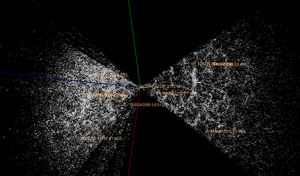Redshift survey

In
Generally the construction of a redshift survey involves two phases: first the selected area of the sky is imaged with a wide-field telescope, then galaxies brighter than a defined limit are selected from the resulting images as non-pointlike objects; optionally, colour selection may also be used to assist discrimination between stars and galaxies.[4] Secondly, the selected galaxies are observed by spectroscopy, most commonly at visible wavelengths, to measure the wavelengths of prominent spectral lines; comparing observed and laboratory wavelengths then gives the redshift for each galaxy.
The
The first systematic redshift survey was the CfA Redshift Survey of around 2,200 galaxies, started in 1977 with the initial data collection completed in 1982. This was later extended to the CfA2 redshift survey of 15,000 galaxies,[5] completed in the early 1990s.
These early redshift surveys were limited in size by taking a spectrum for one galaxy at a time; from the 1990s, the development of fibre-optic spectrographs and multi-slit spectrographs enabled spectra for several hundred galaxies to be observed simultaneously, and much larger redshift surveys became feasible. Notable examples are the
ZFOURGE or the FourStar Galaxy Evolution Survey is a large and deep medium-band imaging survey which aims to establish an observational benchmark of galaxy properties at redshift z > 1. The survey is using near-infrared FOURSTAR instrument on the Magellan Telescopes, surveying in all three HST legacy fields: COSMOS, CDFS, and UDS.[6]
Because of the demands on observing time required to obtain spectroscopic redshifts (i.e., redshifts determined directly from
See also
- Baryon acoustic oscillations
- Intensity mapping
- Large-scale structure of the cosmos
- Redshift-space distortions
- Galaxy filament
